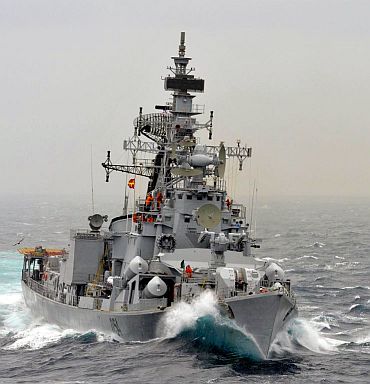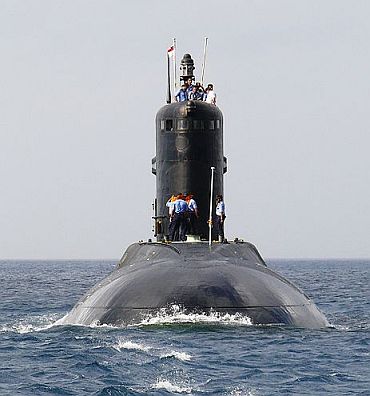
C Raja Mohan, Strategic Affairs Editor with the Indian Express, in a three-part series analyses the unfolding geopolitical change in the Indian Ocean and details the challenges that it poses for India's foreign and security policies.
Part I: A new power equation is arising in Indian Ocean
In the second of the three part series, the strategic expert observes that as India moved from the expansive internationalist vision of Jawaharlal Nehru to the narrower worldview of the Indira years, the pursuit of 'strategic autonomy' became an important theme in the Indian foreign policy discourse.
As a new maritime imperative envelops Beijing and Delhi, the political elites in both capitals have had the challenge of reorienting their world view to an outward looking, globalizing maritime strategy. It is no secret, however, that the Chinese mandarins have begun to respond faster and more purposefully than their India counterparts.
What are the specific new challenges that India faces as it become a major power with significant maritime interests and substantive naval capabilities? Let me focus on five broad issues. My emphasis will not be on the technical details of India's maritime strategy. Instead I will focus on the difficult policy transitions that India has to complete.
This involves the resolution of the tensions between the old principles that have been held dear by three generations of Indians and the new imperatives that confront Delhi's decision makers.
Click on NEXT to read further...

Most analysts of Indian foreign and security policy, whether at home or abroad, would tell you that the organizing principle of India's international relations is the notion of 'strategic autonomy'. It is worth exploring when exactly this phrase started appearing in the articulation of Indian worldview.
Meanwhile, I am quite happy to go along with a recent description of the phrase by a French Scholar, Guillem Monsonis, as a "realist mutation of the traditional non-aligned posture".
My guess is that as India moved from the expansive internationalist vision of Jawaharlal Nehru to the narrower worldview of the Indira years, the pursuit of 'strategic autonomy' became an important theme in the Indian foreign policy discourse.
The Indira Gandhi years saw India steadily retreat from the global economy, become more distrustful of the West, and morph into an insular if not a xenophobic state. As the international system mounted pressures on India's strategic programmes, Delhi's emphasis was inevitably on protecting its much-vaunted strategic autonomy.
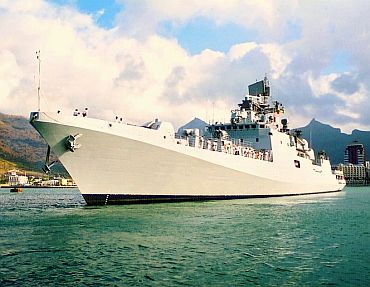
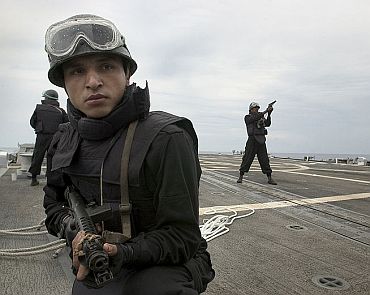
But the international pressure on India to take a larger role in the region and the world will be relentless. As in the case of China, so in the case of India, the compulsion will be to act as a "stakeholder" rather than a 'free rider'.
This will be especially true of the maritime domain, where the weight of the growing naval power is now consequential for the ordering of the security complexes in the Indian and Pacific Oceans.
Towards power projection
The first is about the very conception of India's role in the Indian Ocean and the waters beyond. Since independence, India's traditional impulse was to protect its own territory and the waters around it.
The Partition of the subcontinent and the creation of new borders made internal conflict in the Subcontinent a perennial one; the emergence of China as a new land neighbour after its control of Tibet added to India's security burdens.
If India's land forces were weighed down by the defence of its borders, India's naval strategy too was guided by the imperative of protecting the territorial waters and its large exclusive economic zone.
As the logic of economic globalization unfolded over the last two decades, the Indian naval leadership began to invent a new maritime strategy that is in tune with its new circumstances.
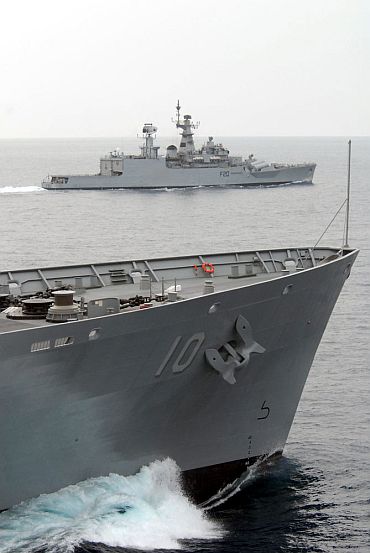
Not surprisingly since the late 1990s, the two Prime Ministers we have had -- Atal Bihari Vajpayee and Manmohan Singh -- repeatedly underlined the expanded geographic scope of India's maritime interests.
The phrases from 'Aden to Malacca' or 'the Suez to the South China Sea' were re-injected into the national security discourse. That this is not an empty talk is reflected in the operations of the Indian Navy that has frequently shown the Tricolour in waters as far apart as the North Atlantic and the South Pacific and from the Mediterranean to the Sea of Japan.
More importantly, anti-piracy activity in the Gulf of Aden (since 2008) and relief operations in the Mediterranean (2006) and the Indian Ocean (2004-05) have underlined the growing capacity of the Indian Navy and the new political will in Delhi to act far from its shores.
Like India, China too is following the logic of what it calls 'far sea defence'. The difference, however, is in the level of political and policy commitment to the construction of a maritime grand strategy.
In China, President Hu Jintao underscored the relationship between Beijing's expanding global interests and the 'historic missions" of the PLA Navy amidst China's rise on the world stage.
What is missing in Delhi is that passion for maritime strategy among its political leadership and the business-as-usual approach by the bureaucratic leadership of the government.
